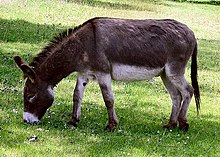Panperissodactyla
Appearance
| Mesaxonia | |
|---|---|

| |
| Donkey, Equus africanus | |

| |
| Macrauchenia patachonica | |
| Scientific classification | |
| Domain: | Eukaryota |
| Kingdom: | Animalia |
| Phylum: | Chordata |
| Class: | Mammalia |
| Mirorder: | Euungulata |
| Clade: | Mesaxonia Marsh, 1884 |
| Families and Orders | |
Mesaxonians are a clade of ungulates whose weight is distributed on the third toe on all legs through the plane symmetry of their feet. For a while it was often seen to only contain the order Perissodactyla (which includes the equines, rhinos and tapirs). Recent work in morphological cladistics and ancient DNA suggests that several extinct lineages, like the Desmostylia and some of the South American ungulates of Meridiungulata (both groups seen as Afrotherian relatives) are related to the perissodactyls.[1][2]
References
- ^ a b c Cooper, L. N.; Seiffert, E. R.; Clementz, M.; Madar, S. I.; Bajpai, S.; Hussain, S. T.; Thewissen, J. G. M. (2014-10-08). "Anthracobunids from the Middle Eocene of India and Pakistan Are Stem Perissodactyls". PLoS ONE. 9 (10): e109232. doi:10.1371/journal.pone.0109232. PMC 4189980. PMID 25295875.
{{cite journal}}: Invalid|ref=harv(help)CS1 maint: unflagged free DOI (link) - ^ a b Qiu, L. (2014-10-08). "Ancient "Oddball" Mammal Reshuffles Family Tree?". National Geographic Society. Archived from the original on 2014-10-11. Retrieved 2014-10-11.
- ^ a b Welker, Frido; Collins, Matthew J.; Thomas, Jessica A.; Wadsley, Marc; Brace, Selina; Cappellini, Enrico; Turvey, Samuel T.; Reguero, Marcelo; Gelfo, Javier N. (March 18, 2015). "Ancient proteins resolve the evolutionary history of Darwin/'s South American ungulates". Nature. advance online publication: 81–84. doi:10.1038/nature14249. ISSN 1476-4687. Retrieved 2015-04-30.
